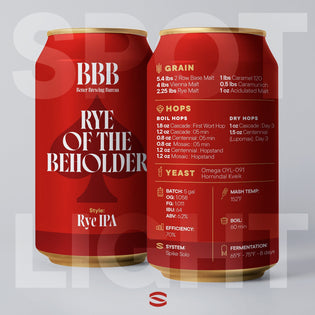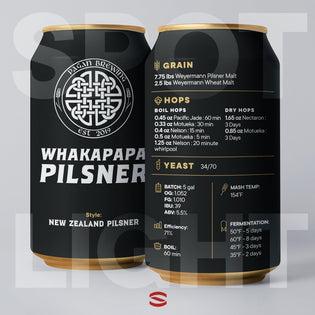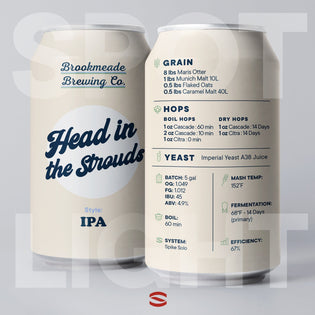
The Brewer: Greg Corbu
My name is Greg, and I have been homebrewing for three years. Earlier this year I finally upgraded to the Flex+ fermenter. I had previously used other brands' stainless-steel fermenters but wanted the ability to ferment under pressure and do pressurized transfers to keg to reduce oxidation during the transfer process. I couldn’t be happier with the Flex+ and can't wait to add more of them to my arsenal!
The Beer: Kettle Sour
If you've always wanted to brew sour beers but felt it was too daunting of a task, I can vouch for the simplicity and effectiveness of kettle souring this recipe. The nice thing about this recipe is that if you don't want to take the extra step to sour the wort, you'll end up with a beautifully hazy New England style IPA.
Poor Helen is a kettle soured beer. I used a lot of high protein grains (spelt malt, red wheat malt, and flaked oats) in my grist to encourage haze formation and for a fuller bodied mouthfeel. For more residual sweetness I included a 10% addition of Vienna malt.

Once final gravity is reached, transfer beer to keg and add 10 packets of unsweetened Tropical Punch Kool-Aid powder directly to keg. Shake filled keg and pressurize with CO2 until desired carbonation is reached.
The Recipe: Poor Helen

INGREDIENTS
GRAIN
- 10.6 lbs Pilsner
- 1.6 lbs Spelt Malt
- 1.6 lbs Red Wheat Malt
- 1.5 lbs Vienna Malt
- 1 lbs Flaked Oats
HOPS
- Boil hops: 1.5 oz Citra-Whirlpool: 0:20
- 0/5 oz Mosaic-Whirlpool: 0:20
YEAST
- Bootleg Biology Sour
- Weapon L& Lallemand
- Verdant Ale Yeast

INSTRUCTIONS
BATCH SIZE: 5 gal
OG: 1.063
FG: 1.016
IBU: 11
ABV: 6.2%
EFFICIENCY: 72%
MASH TEMP: 155 ºF
BOIL: 30 min
FERMENTATION: 70 ºF - 10 days
![]() Pro Tips
Pro Tips
Ultimately with this beer I just wanted to have fun! I kept the hop addition light with no bittering hops or dry hops, just a whirlpool addition, since I knew Kool-Aid powder would dominate.
The final product is an adult take on fruit punch. Extreme puckering sourness combines with a full body and slight malt sweetness for balance. The Citra and Mosaic LUPOMAX hops gave the beer a citrusy base, perfect for the addition of tropical fruit flavors to be added later on.
The grist and hops for this beer could work as a hazy IPA, sour IPA, or fruited IPA. I love the versatility of this recipe and will probably use the same grain bill on my next hazy IPA!
Cheers,
Greg Corbu – Crow Point Brewing
Spike Summarizes: All Things Sour Beer
What is sour beer?
Sour beer is a unique and diverse style of beer with a tangy, complex flavor. It’s created by adding wild yeast and bacteria to the brewing process. This results in a beer that has a tart, acidic taste and an earthy aroma.
The overall color can range from pale yellow to deep brown. The strength also ranges from light and refreshing to strong and complex.
What does sour beer taste like?
Sour beer is a unique and complex style that can be difficult to describe. It has a tart, acidic flavor that is often compared to a sour candy or fruit juice.
The flavor may also vary depending on the type of yeast used and the amount of time it has been aged. Sour beers often have a dry finish and can be light or full-bodied. However, they are usually low in hops and have a low to moderate alcohol content.
What is the history of sour beer?
Sour beer has been around for centuries, but it wasn't until the 1800s that brewers began to understand the science behind the process. In the mid-1800s, Louis Pasteur discovered the role of yeast in fermentation and this led to a better understanding of the process of spontaneous fermentation.
By the early 20th century, brewers had developed techniques to control and manipulate the process, producing a variety of sour beers.
Today, sour beer is a popular beer style with a wide range of flavors and styles. From light and tart Berliner Weisse to complex and funky Lambic, there’s a sour beer for everyone!
What are some types of sour beer?
American Wild Ales
American Wild Ales are brewed with wild yeast strains, such as Brettanomyces and Lactobacillus, which give the beer its signature sour taste. They are often brewed with various fruits, spices, and other ingredients to create a truly unique flavor profile.
Berliner Weisse
Berliner Weisse is a type of sour beer that originated in Berlin, Germany. It’s a light-bodied, highly carbonated wheat beer. Usually pale yellow in color, it has a tart, lemony flavor with a dry finish.
It’s traditionally brewed with a combination of wheat and barley malts, and fermented with a combination of lactic acid bacteria and yeast. This beer style is often referred to as "the champagne of the north" due to its light, refreshing flavor and low alcohol content.
East Flanders Brown Ale/Oud Bruin
East Flanders Brown Ale, also known as Oud Bruin, is a unique type of beer that originated in the East Flanders region of Belgium. This style of beer is dark, malty, and slightly sour, with a unique flavor profile that’s unlike any other beer.
With a deep, reddish-brown hue, this beer tastes complex and nuanced, with a malty sweetness that is balanced by a tart, acidic flavor.
Gose
Gose is a type of sour beer that originates from Goslar, Germany. It’s a top-fermented wheat beer with at least 50% malted wheat and a small amount of lactic acid bacteria. It’s also considered a light-bodied beer, often with a slightly salty or tart taste.
Gose is also brewed with coriander and salt, which adds to its unique flavor profile. Don’t be alarmed by the cloudy appearance as it’s often unfiltered.
Gueuze
Gueuze is a traditional sour beer style originating in Belgium. This is a blend of young and old lambics, which are spontaneously fermented ales. Gueuze is characterized by its bright, tart, and complex flavor profile, resulting from the combination of the two lambic beers.
Often referred to as "the champagne of Belgium" due to its effervescence and light, refreshing taste. The flavor profile is distinct with notes of lemon, apple, and hay and a hint of funkiness from the wild yeast.
Lambic
Lambic is a traditional Belgian beer style that is produced in the Senne Valley near Brussels. It’s made with a unique blend of malted barley, wheat, and aged hops. The most distinctive feature of Lambic is its fermentation process.
Unlike other beers, Lambic beers are spontaneously fermented using wild yeasts and bacteria that are naturally present in the air. This process creates a unique flavor profile that is tart, complex, and refreshing. Lambic beers are typically low in alcohol and can range from light and refreshing to dark and complex.
West Flanders Sour Red Ale
West Flanders Sour Red Ale is a unique and complex type of sour beer originating from the Flanders region of Belgium. This traditional style is brewed with a combination of malts and aged hops, and fermented with a special blend of wild yeast and bacteria.
The result is a beer with a deep ruby color and a tart, fruity aroma. The flavor is complex and tart, with notes of cherry, plum, and raspberry. It has a dry finish and a light to medium body. The beer is often aged in oak barrels, which adds a subtle woody character and contributes to the beer's complexity.
What are the steps to make sour beer?
What do I pair with sour beer?
Sour beers are a great accompaniment to cheeses, as the acidity of the beer can help to bring out the flavors of the cheese. Try pairing a sour beer with a sharp cheddar, a soft brie, or a blue cheese for maximum flavor potential!
For a sweet and savory treat, pair a sour beer with a dessert such as apple pie or chocolate cake. The acidity of the beer will help to balance out the sweetness of the dessert and bring out the flavors of the dish.
Are sour beers an acquired taste?
Sour beers can be an acquired taste for some, but many people find them to be quite enjoyable. The unique flavor profiles of sour beers can be an acquired taste, but they are often quite refreshing and can pair well with certain foods.
If you’re looking to try sour beers, it’s best to start with a lower ABV beer, as these tend to be less intense and more approachable.
Are sour beers strong?
Sour beers can range from light to strong in terms of their alcohol content. Generally, sour beers tend to be on the lower end of the alcohol content scale, with most sour beers ranging from 3-7% ABV.
Are sour beers high in sugar?
Sour beers typically contain a small amount of residual sugar, but are not considered to be high in sugar. The amount of sugar in a sour beer will depend on the style and the brewing process.
Is sour beer like cider?
Sour beer and cider are both fermented beverages, but they are not the same. Cider is made with fermented apples, while sour beer is made with beer ingredients such as hops, malt, and yeast.
Also, sour beer is often fermented with wild yeast and bacteria, giving it its unique flavor profile.





